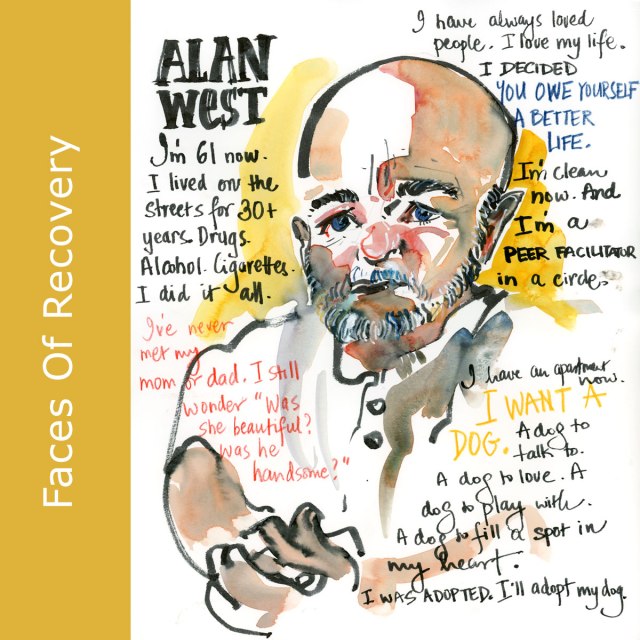More Faces of Recovery .
Tony‘s story.
And Alan‘s. It’s funny how portrait drawing works: Alan smiles so much, he is funny and optimistic, and yet I couldn’t get past the his blue eyes, they looked so sad.

And, Agustin.

I’m learning as I do these. And I’m using things I’ve learnt before too.
– Sketching on location in public places has taught me to work when being watched, and that’s super helpful.
– More importantly, though, I’ve learnt to stop voicing my anxiety about how a piece is going, or to constantly comment on something that didn’t quite work out: especially with this project, it isn’t about me and my drawing, and it isn’t about how technically correct something is. A portrait will work if I can stay present and capture character, and that means listening to the story I’m being told, not just drawing facial features.
Find every story recorded so far here.



I can see the stories in your scetches. Well made!
LikeLiked by 1 person
I’m really enjoying reading about your Faces project and seeing your wonderful expressive sketches! Would love to talk and share experiences some time. It’s such a heart opening experience to get to hang out with these folks and hear their stories. I’m doing a series of homeless women and their pets now which brings a lot of issues into focus. -Susan
Sent from my iPad
>
LikeLiked by 1 person
Susan, we need to meet and talk sometime!
LikeLike
These were the best thing I’ve seen in a long time. A couple actually brought tears to my eyes. Thank you!!
LikeLike
Thank YOU john, for reading along.
LikeLike
Suhita , this is a great project you are on! I enjoyed so much the stories you share and your ability to show these people’s feelings, and profound humanity despite the despair they went through. You have an incredible way of being a witness and letting everyone’s voice heard. I wish I had the talent to sketch people so to do the same thing here in Adelaide where I live. I found the Recovery Cafe an amazing human adventure! keep these stories coming.
LikeLike
Thank you Agnes, hoping to keep at the project for a while and collect more stories.
LikeLike
The project seems to go on well. Turn your eyes on to the subaltern classes including
Dalits, untouchables, transgenders and the unnoticed ones because their stories are the least heard. They do want to talk. Go on.. Find more who belong to the lowest strata of society. It helps you to learn life more and to lead a life worthwhile
LikeLike
I really love ‘meeting’ the people you are listening to and drawing. I feel a mixture of empathy, sadness, amazement and complete respect at people’s courage and determination in the face of some really tough circumstances. It could happen to any of us and who knows how we might respond.
LikeLiked by 1 person
You are so right Caroline, and that’s really the point of the stories. We often see differences, but in truth, the similarities are bigger.
LikeLike
P.S. I meant to add, lots of hope too in their stories of recovery.
LikeLiked by 1 person
Caroline, you’re spot on with how i feel about this. Thank you for reading
LikeLike
Yes, a LOT of hope, and so much strength!
LikeLike
“More importantly, though, I’ve learnt to stop voicing my anxiety about how a piece is going, or to constantly comment on something that didn’t quite work out: especially with this project, it isn’t about me and my drawing, and it isn’t about how technically correct something is. A portrait will work if I can stay present and capture character, and that means listening to the story I’m being told, not just drawing facial features.” So true and wise – but far from easy. Kudos for this work.
LikeLiked by 1 person
Michael, true, it’s not easy, but it comes with practice. I find I still get anxious about a piece not going like i expect it to, but I’ve learnt to keep focussed on my subject, not me, and it always helps.
LikeLike